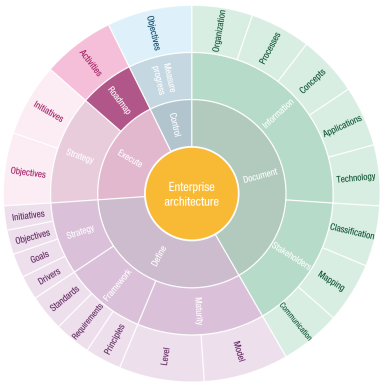A Roadmap is a timeline of previously defined initiatives in the form of work packages. In order to complete stage three (Execute) of the Enterprise Architecture Implementation Wheel, specifically the step of creating a roadmap, two things need to be accomplished. First, an overview of the planned initiatives that will flesh out the roadmap is needed. Secondly, it is recommended that these initiatives be related to business goals and objectives.

Work packages and initiatives
Work packages are very similar to initiatives, if not the same. For example, a cluster, set, or grouping of multiple work packages can be considered an initiative. These clusters of work packages often form a project, program, or even a portfolio. Initiatives do the same.
A work package generally does not describe an ongoing activity such as a business process. The subject of the work package is performed once and produces a well-defined end result. This is usually a goal or objective. A work package can be used to model tasks within a project, entire projects, programs, or entire portfolios. In an agile context, a work package can be used to model the work done in an agile iteration (e.g., a sprint) or in a higher-level increment. Initiatives work in similar fashion.
Conceptually, a work package is similar to a business process in that it consists of a series of related tasks aimed at producing a well-defined end result. In terms of content, a work package can be said to be a unique and one-time process; it performs a series of activities that lead to an end result. A work package can be described in much the same way as a process.
Roadmap
A roadmap shows which work packages are related to which goals or intended objectives. Owners and (progress) states can be assigned to the work packages. Thus, a roadmap can be used to monitor the progress of the implementation of the organization’s strategy.
This is where stages one, two, and three of the Enterprise Architecture Implementation Wheel come together. An architecture roadmap uses these stages to provide a clear and predictable view of the impact of the defined initiatives on the organization. The first two stages of the Enterprise Architecture Implementation Wheel produced deliverables. These deliverables help shape the necessary changes; they provide the information needed to make sense of the organizational changes. The deliverables are the end products of the individual work packages. Representing the work packages in the roadmap clarifies when the architecture deliverables will be created and delivered.
Architecture artifacts and deliverables
The second step of stage three (Execute) handles the creation of one artifact and one deliverable. The artifact involves creating a Work Package Portfolio Map. This activity consists of identifying and shaping the initiatives to be implemented. The deliverable concerns the creation of the Architecture Roadmap.

